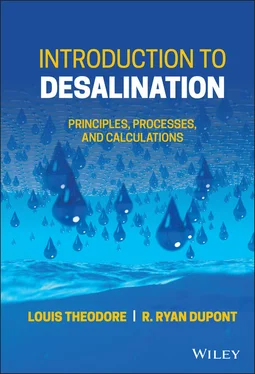Duct – A round or rectangular conduit, usually metal or fiberglass, employed to transport fluids, usually air.
Dystrophic lake – An acidic, shallow body of water that contains high concentrations of humic substances and organic acids that are often brown in color; it contains many plants but few fish.
Ebb tide – The tide occurring at the ebb period of tidal flow; it is sometimes referred to as falling tide to describe the direction of the current.
Ecosphere – The global sum of all ecosystems on Earth.
Ecosystem – The interacting system of a biological community and its nonliving surroundings.
Eddy – A circular movement occurring in flowing water caused by currents in the water induced by obstructions or changes and irregularities in the banks or bottom of the channel, or by differences in temperature.
Effluent – Any fluid emerging from a pipe or similar outlet that enters the environment; it usually refers to treated wastewater from municipal or industrial treatment plants.
Electrolysis – The use of a direct electric current to drive an otherwise non-spontaneous chemical reaction.
Elution – The process of moving a substance through a bed by means of a slow-moving stream.
Elutriation – A process for separating particles based on their size, shape, and density, using a stream of gas or liquid flowing in a direction usually opposite to the direction of sedimentation. This method is mainly used for particles smaller than 1 μm.
Empirical – Anything derived from experimentation or observation and not from fundamentals or theory.
Endothermic – A term used to describe a process or change that occurs with absorption of heat.
Enrichment – The addition of constituents, generally nutrients, from wastewater treatment plant effluent or agricultural runoff to surface water.
Environment – The system of external conditions affecting the existence and development of an individual or organism.
Environmental audit – An independent assessment of the current status of a company’s compliance with applicable environmental requirements.
Epidemiology – The study of diseases as they affect population, including the distribution of disease, or other health-related states and events in human populations, the factors that influence this distribution, and the application of this study to control health problems.
Erosion – The breakdown of solid rock into smaller particles and its removal by wind, water, or ice; the removal of surface soil by wind, water, or ice.
Estuary – A region of interaction between rivers and near-shore ocean water where tidal action and river flow create a mixing of fresh and saltwater.
Euphotic zone – The upper zone of a sea or lake into which sufficient light can penetrate for active photosynthesis to take place.
Eutrophic lake – A body of water that is characterized by an abundant accumulation of nutrients that support a dense growth of algae and other organisms, the decay of which depletes the shallow waters of oxygen in summer.
Eutrophication – The process by which a body of water becomes enriched in dissolved nutrients (such as phosphates) that stimulate the growth of aquatic plant life usually resulting in the depletion of dissolved oxygen.
Evaporation – The conversion of a liquid into a vapor.
Evaporation pond – A shallow pond or impoundment with a large surface area that is designed to contain wastewater and allow it to evaporate with no discharge to the environment.
Excursion – An unintentional occurrence, such as a discharge of pollutants above the permitted amount, due to unplanned reasons.
Exempted aquifer – An underground body of water defined in the underground injection control program as an aquifer that is “not reasonably expected” to be a source of drinking water and that is exempted from regulations barring underground injection activities.
Exothermic – A term used to describe a reaction or process during which heat is released.
Faucet aerator – Device that can be installed in a sink to reduce water use.
Feed – The material supplied to a processing unit for treatment or processing.
Feedforward control system – A system in which changes are detected at the process input and an anticipated correction signal is applied before process output is affected.
Feedstock – The raw materials supplied to manufacturing or processing plants for use in the production of goods or materials.
Film-type condensation – The process by which a saturated vapor comes into contact with a surface whose temperature is below the saturation temperature and uniformly condenses on the surface.
Filter membrane – A thin film containing many fine pores that is employed to filter a liquid or solid stream.
Filter press – A mechanical device that forces sludge, usually conditioned with coagulant addition, between moving filter membranes to squeeze water out of it and produce a dry sludge cake of between 15 and 25% solids.
Finished water – Water that has been treated and is ready to be delivered to customers.
Flash drum – A unit in which volatile components are vaporized and separated from a liquid stream for further fractionation.
Flash evaporator – A distillation device in which saline water is injected in a superheated state into a vessel under vacuum and in which boiling occurs without the usual heat source.
Flocculation – The process by which solids in water or sewage are made to increase in size by biological or chemical action so that they can be more easily separated from the water by sedimentation.
Fluid – Any material or substance that changes shape or direction uniformly in response to an external force imposed on it; the term applies to liquids and gases.
Fluidization – A technique in which a finely divided solid is caused to behave like a fluid by suspending it in a moving gas or liquid.
Fluoridation – The addition of fluoride to public water supplies to prevent or delay the onset of dental decay.
Fractional distillation – A distillation process in which countercurrent distillation is employed to obtain a product as nearly pure as possible; it is also any distillation process in which the product collected may be a series of separate components of similar boiling range.
Freeze-drying – A method of dehydration or separating water from materials; the material is first frozen and placed in a high vacuum so that the water (ice) vaporizes (sublimes) in the vacuum without melting and the non-watery components are left behind in an undamaged state.
Freshwater – The water that generally contains less than 1,000 mg/L of dissolved solids.
Froth – A foamy mass of bubbles that exists on a body of water.
Gas permeation – The movement of gas from the high pressure side of a membrane to the low pressure side.
Geohydrology – The branch of hydrology involving the study of groundwater and its physical and chemical interactions with the physical environment.
Geology – The science that deals with the origin, history, and structure of the Earth, as recorded in rocks, along with forces and processes that modify rocks.
Geothermal energy – The energy derived from the superheated water and steam trapped in underground reservoirs.
Geothermal gradient – The change of temperature in the Earth with depth, usually expressed in degrees per unit of depth.
Glacial drift – The rock material transported and deposited directly by glaciers or indirectly by ice or water emanating from a glacier.
Glacier – A large body of ice originating on land by the compaction and recrystallization of snow, and showing evidence of present or past movement.
Grab sample – A sample that is collected at such a time and place so that it is ideally most representative of a total discharge.
Читать дальше












